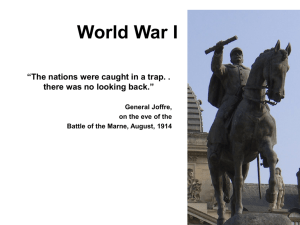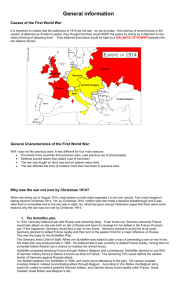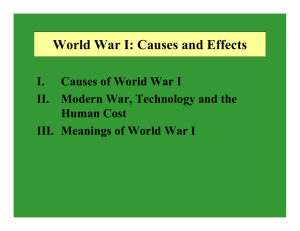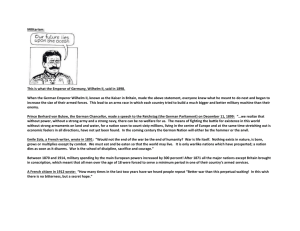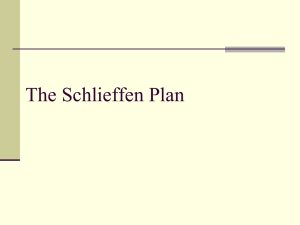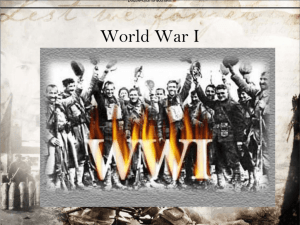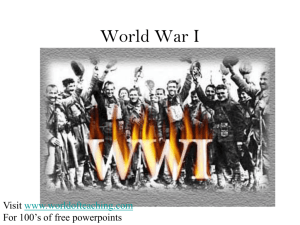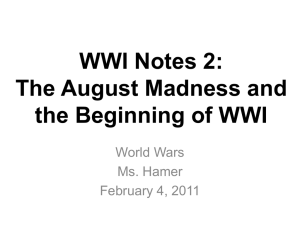How was the great war fought 1914 18
advertisement
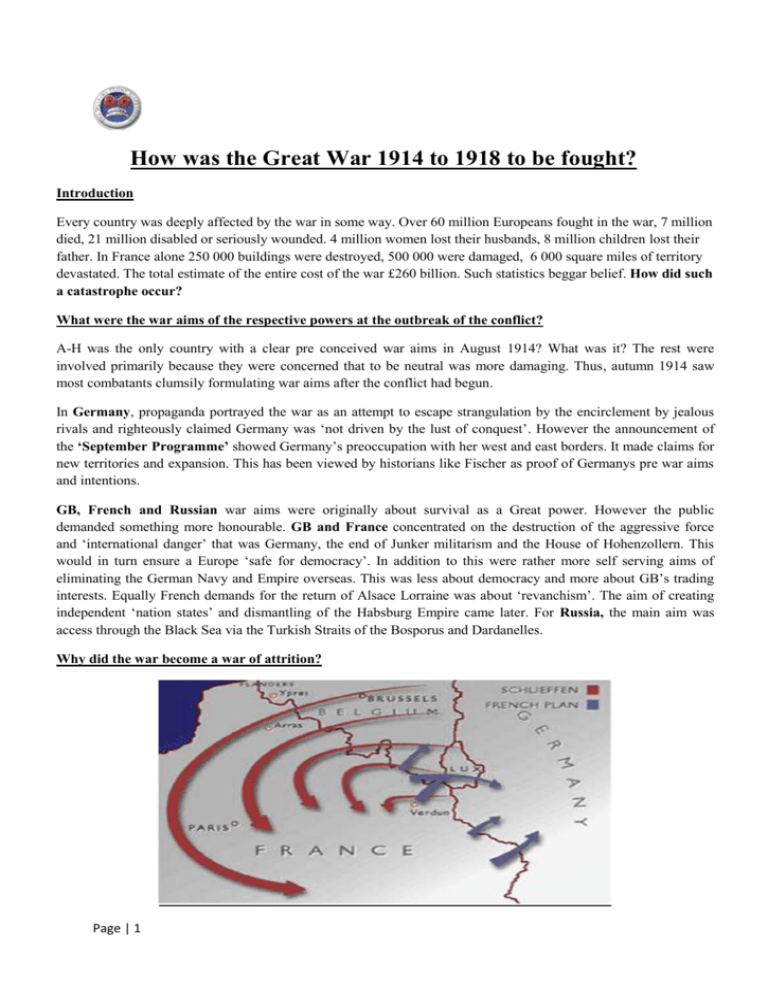
How was the Great War 1914 to 1918 to be fought? Introduction Every country was deeply affected by the war in some way. Over 60 million Europeans fought in the war, 7 million died, 21 million disabled or seriously wounded. 4 million women lost their husbands, 8 million children lost their father. In France alone 250 000 buildings were destroyed, 500 000 were damaged, 6 000 square miles of territory devastated. The total estimate of the entire cost of the war £260 billion. Such statistics beggar belief. How did such a catastrophe occur? What were the war aims of the respective powers at the outbreak of the conflict? A-H was the only country with a clear pre conceived war aims in August 1914? What was it? The rest were involved primarily because they were concerned that to be neutral was more damaging. Thus, autumn 1914 saw most combatants clumsily formulating war aims after the conflict had begun. In Germany, propaganda portrayed the war as an attempt to escape strangulation by the encirclement by jealous rivals and righteously claimed Germany was ‘not driven by the lust of conquest’. However the announcement of the ‘September Programme’ showed Germany’s preoccupation with her west and east borders. It made claims for new territories and expansion. This has been viewed by historians like Fischer as proof of Germanys pre war aims and intentions. GB, French and Russian war aims were originally about survival as a Great power. However the public demanded something more honourable. GB and France concentrated on the destruction of the aggressive force and ‘international danger’ that was Germany, the end of Junker militarism and the House of Hohenzollern. This would in turn ensure a Europe ‘safe for democracy’. In addition to this were rather more self serving aims of eliminating the German Navy and Empire overseas. This was less about democracy and more about GB’s trading interests. Equally French demands for the return of Alsace Lorraine was about ‘revanchism’. The aim of creating independent ‘nation states’ and dismantling of the Habsburg Empire came later. For Russia, the main aim was access through the Black Sea via the Turkish Straits of the Bosporus and Dardanelles. Why did the war become a war of attrition? Page | 1 Put simply, the German and French war plans failed. Both the Schlieffen Plan and the French Plan XVII were offensive plans, the emphasis being surprise attack. Victory would be assured within 6 weeks or so. However both plans had significant flaws. Germany’s Schlieffen Plan was a very rigid, detailed plan that was dependent on all or, at very least, most parts working to perfection without delays of bombed bridges, roads or valiant resistant. Yet despite these flaws, the Schlieffen Plan very nearly worked. Belgium succumbed in 2 weeks and the French army was being held up at the Ardennes and in Lorraine with heavy casualties. The BEF was also in retreat although it had had some success in delaying the German advance at Mons. However the main failing of the plan was the loss of nerve by Generals Kluck and Moltke. They decided to go east of Paris and not carry on round the west as the plan stipulated. They feared a break in the line and so took the conservative option of trying to encircle Joffre’s retreating army. This led to the Battle of the Marne in Sept 1914. The BEF and French forces succeeded in halting the German attack but were not able to force them back. They had taken up exceptionally strong defensive lines by the River Aisne. In turn both sides fought to outflank each other so began the ‘Race to the sea’, reaching the Channel by Nov 1914. Thus the pattern of the next 4 years was set with an unbroken line of trenches from the coast to the Alps stretching over 400 miles. The ‘war of movement’ was brought to an end. The huge casualty rates (In some quarters up to 40%) and depletion of supplies/munitions led both sides to draw breath and ‘dig in’ for a form of warfare that neither had experienced nor planned for. What role did new technology play? This was the first really industrialised war where the combatants had the capacity to wage war on a scale otherwise unimagined. Heavy artillery and machine guns had been used before but never with such deadly consequences. Hundreds of thousands dead on all sides within a few months, even more injured or captured. Aircraft, gas and later tanks were all utilised e.g. gas was used by the Germans in April 1915, just outside Ypres, for the first time. The machine gun was an effective defence against attack but was too cumbersome to be used as an assault weapon. None of the new technology brought a breakthrough in 1915, 1916 nor 1917. Whatever each side threw at the other, it seemed to absorb and withstand. The network of trenches (front, reserve and support plus all the communication trenches) ensured that an attempt to capture any part was going to prove very difficult. In addition to this the German strategy of withdrawing to high ground and building deep, concrete lined trenches meant that the GB and French forces had an almost impossible task. Page | 2

